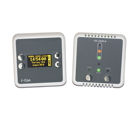Joined-up thinking

Malcolm Anson of Clarkson Controls shares his frustration about controls that do not operate in harmony — and illustrates his point with a new product.
Anyone involved in the building-controls industry will have been in an office, meeting room or class room and been aware of a proliferation of sensors, thermostats and switches placed at various points within the same room.
What does this mean?
In all probability it tells us, as controls engineers, that there hasn’t been any joined up thinking! Each piece of control equipment will be working to its own preset agenda — with controls for heating, cooling and ventilation controls all working independently with no interlocks between them.
In fact, it’s not untypical to have the underfloor heating on in a room while the natural-ventilation louvres are open, trying to manage and control the temperature.
This just doesn’t make sense.
Besides the ugly appearance of a ‘forest’ of sensing devices in one room, the challenge of interlocking each sensor and control together so they all work to achieve the desired room temperature becomes ever-more difficult — not forgetting the amount of wiring and installation time to wire each device back to the controlling outstation.
Not only is this expensive, with all the individual bits of equipment, materials and installation time, it also adds to the commissioning work load, which as we all know is usually at the tail end of the contract when time is tight and we have so much to complete and sign things over.
The solution is joined-up thinking, to solve this complicated problem in an intelligent way.
Clarkson Controls has come up with just such a solution by designing and developing the i-con CO2 room sensor and i-con graphical user interface (GUI) that together reduce the number of devices required within a room. Making use of simple 2-wire, non-polarised connection to a standard UK knock-out switch box — all of which will make the lives of control engineers and installers as simple as possible.
The i-con controllers provide all the algorithms necessary for an ‘orchestrated’ approach to room control. Two cores of cable (not six) provide power to the device and communications back to the controller.
The i-con room sensors can be wired in any formation (star, daisy chain) and still give individual data for each room back to the controller. They have a simple ‘traffic-light’ CO2 indicator, with override buttons, which reverts back to Auto after a pre-set time.
It is also easier for Installers and the client to understand and use the product; so often we hear or read that they do not understand the display terminology. The i-con GUI is easy to use and understand with a simple up/down, enter/back, scroll through, menu structure —all delivered via a bright OLED lit screen.
It is time for our Industry to adopt such ‘joined-up thinking’ with devices that will fully ‘conduct the orchestra’ of room control, help achieve better client understanding and operation, and achieve even greater energy savings — as well as reducing installation costs.








